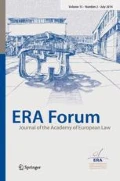Abstract
This article suggests that there are two contradictory approaches to promoting the public interest embodied in the Trade Mark Directive. The ‘external approach’ assumes the Directive will operate in a relatively free market, which determines the penumbra of protection afforded a mark. The ‘internal approach’ assumes courts may intervene to balance the sometimes conflicting interests of different market actors. Recent CJEU case law in relation to the registration of non-distinctive signs (art 3(1)(b–c)) and ‘double identity’ infringement (art 5(1)(a)), which illustrates this contradiction, will be considered. It is argued that the internal approach to protecting the public interest should be favoured.
Similar content being viewed by others
Notes
The First Council Directive of 21 December 1989 to approximate the law of the Member States relating to trade marks (2008/95/EC; formerly EEC 89/104).
Davis [2].
Motta [14].
Max Planck [10].
See for example, Case C-48/09 Lego Juris A/S v OHIM [2010] ECR I-08403 63, para 43.
Case C-299/99 Koninklijke KPN Nederland NV v Remington Consumer Products Ltd. [2002], ECR I-5475.
Case C-456/01P and C-457/01P Henkel KGaA v OHIM (Joined cases) [2004], ECR. I-5089at para 48.
Case C-108/97 Windsurfing Chiemsee Produktions-und Vertriebs GmbH v Boots-und Segelzubehor Walter Huber [1999] ECR I-2779 at para 25.
Case T-435/11 Universal Display Corp v OHIM judgement of 2 May 2012 (not yet published).
Case C-104/01 Libertel Groep BV v Benelux Merkenbureau [2003] ECR I-3793 at paras. 54–60.
Davis [3].
Coca Cola Trade Marks (1986) RPC 421 at 456.
YORK Trade Mark [1984] RPC 231.
For example, Nola, 14 January 1963, Bundesgerichtshof (Ib ZB 29/62) [1963] Gewerblicher Rechtsschutz and Urheberrecht 469.
Windsurfing at para 30.
Case-53/01 Linde AG’s Trade Mark Application [2003], ECR I-3161 at paras. 48. 75–77.
Provided of course it did not fall foul of art 3(1)(e)–(g) TMD; Philips at para 39. Suthersanen [17].
In these cases, their equivalents: art 7(1)(b) and 7(1)(c) CTM (CTM Regulation (Council Regulation (EC) No 207/2009; formerly Council Regulation (EC) 40/49).
Case T-23/07 Borco v OHIM BORCO-Marken-Import Matthiesen GmbH & Co KG v OHIM [2009], ECR II 00887 (General Court); C-265/09 P BORCO-Marken-Import Matthiesen GmbH & Co KG v OHIM [2011], ECR I-08265 CJEU
Case C-51/10 P Technopol (Agencja Wydawnicza Technopol sp. z o.o. v OHIM [2011], ECR I-01541.
Borco at para 49.
Borco at paras. 48–49.
Borco at para 49.
Case-136/02 P Mag Instrument Inc v OHIM [2004], ECR I-9165.
The CJEU cited (at para 33) it decision in Procter a Gamble as a precedent to this effect. Case-437/01P Procter & Gamble v OHIM [2004], ECR 1-5173 at para 33.
Borco, paras. 37 and 38.
Technopol at paras. 32–40.
Case-558/08 Portakabin Ltd v Primakabin BV [2010] ECR I-06963; on exhaustion of rights, see Hays [7].
Case-236/08, Case-238/08 Google France Sarl v Louis Vuitton Mallettier SA [2010], ECR I-2417.
Case-323/09 Interflora Inc v Marks & Spencer Plc, judgement of 22 September 2011 (not yet published).
L’Oreal v eBay at para AG4.
Google at para 91–97; see Simon Fhima [4].
Meale [13].
Interflora v Marks & Spencer at para 35.
Interflora v Marks & Spencer at paras. 54–59.
Interflora v Marks & Spencer at paras. 60–65.
Psaroudakis [16].
Max Planck [10] at para 1.50.
Case-46/10 Viking Gas A/S v Kosan Gas a/s, judgement of 14 July 2011 (not yet published) at para 31. See McEvedy [11].
Viking Gas at para 31.
References
Anderman, S., Ezrachi, A.: Intellectual Property and Competition Law: New Frontiers. OUP, Oxford (2011)
Davis, J.: A European constitution for IPRs? Competition, trade marks and culturally significant signs. Common Mark. Law Rep. 41, 109–112 (2004)
Davis, J.: Protecting the common: delineating a public domain in trade mark law. In: Dinwoodie, G.B., Janis, M.D. (eds.) Trade Mark Law and Theory: A Handbook of Contemporary Research, pp. 345–367. Edward Elgar, Cheltenham (2008)
Simon Fhima, I.: The Court of Justice’s protection of the advertising function of trade marks: an (almost) sceptical analysis. J. Intell. Property Law Practice 6(5), 325–329 (2011)
Gangjee, D., Burrell, R.: Because you’re worth it: L’Oreal and the prohibition on free riding. Mod. Law Rev. 73(2), 282–295 (2010)
Griffiths, A.: Trademarks and responsible capitalism. Int. Rev. Ind. Property Copyr. Law 43(7), 798–824 (2012)
Hays, T.: The free movement (or not) of trademark protected goods in Europe. In: Dinwoodie, G.B., Janis, M.D. (eds.) Trade Mark Law and Theory: A Handbook of Contemporary Research, pp. 204–229. Edward Elgar, Cheltenham (2008)
Horton, A.: The implications of L’Oreal v bellure—a retrospective and a looking forward: the essential functions of a trade mark and when is an advantage unfair? Eur. Intellect. Prop. Rev. 33(9), 550–558 (2011)
Marsoof, A.: Keywords advertising: issues of trade mark infringement. JCL & T 5(4), 240–251 (2010)
Planck, M.: Institute for Intellectual Property and Competition Law: Study on the Overall Functioning of the European Trade Mark System (2011). Available at http://ec.europa.eu/internal_market/indprop/docs/tm/20110308_allensbach-study_en.pdf
McEvedy, V.: Keywords and resales and other fair and referential uses. Intell. Property Q. (3), 149–172 (2012)
Morcom, C.: Trademarks and the Internet: where are now? Eur. Intellect. Prop. Rev. 34(1), 40–53 (2012)
Meale, D.: Interflora: the last word on key word advertising? J. Intell. Property Law Practice 7(1), 11–14 (2012)
Motta, M.: Competition Policy, Theory and Practice. Cambridge University Press, Cambridge (2004)
Posner, R.: A Failure of Capitalism: The Crisis of ’08 and the Descent into Depression. Harvard University Press, Cambridge (2009)
Psaroudakis, G.: In search of trade mark functions: keyword advertising in European Law. Eur. Intellect. Prop. Rev. 34(1), 33–39 (2012)
Suthersanen, U.: The European Court of Justice in Philips v Remington—trademarks and market freedom. Intell. Property Q. (7), 257–283 (2003)
Author information
Authors and Affiliations
Corresponding author
Additional information
This article is based on a presentation given at the Annual Conference on Trademarks and Designs in Europe, organised by ERA on 15–16 November 2012 in Alicante.
Rights and permissions
About this article
Cite this article
Davis, J. Promoting the public interest and the European Trade Mark Directive: a contradictory approach. ERA Forum 14, 117–129 (2013). https://doi.org/10.1007/s12027-013-0288-x
Published:
Issue Date:
DOI: https://doi.org/10.1007/s12027-013-0288-x



